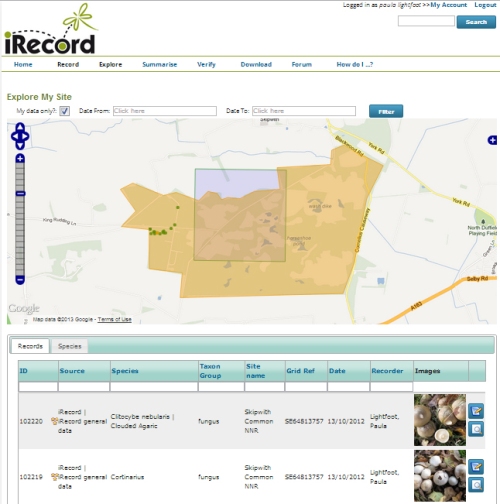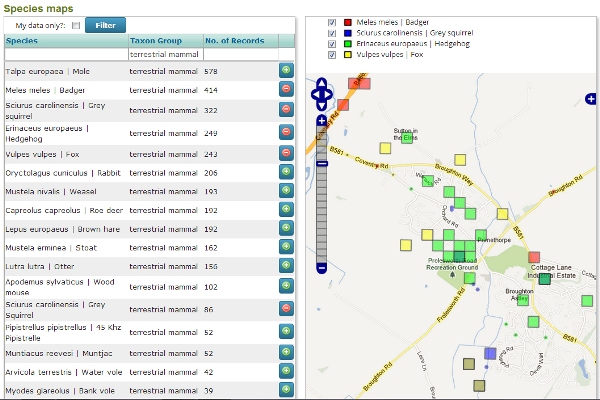The amount of data captured through iRecord and linked Indicia websites and apps is growing steadily. With over 83,000 records now in the system, it won’t be long until we reach our 100,000th record – what will it be?
We have introduced some improvements to help you explore the ever-increasing amount of data; now when you log into iRecord you will see two new options under the Explore tab: My Sites and Species Maps.
My Sites
This feature allows recorders to maintain a list of the sites they visit regularly. This makes it easier to input records from these sites and also enables summary reporting of species found.
There are two ways you can start to build up your own list of favourite sites:
1. When entering a record, if you type in a new site name and grid reference, a ‘remember site’ button will appear, allowing you to save the site when you submit the record. You can draw the exact boundary later using the ‘edit’ button on the My Sites page.
2. Go to the My Sites page and click the ‘add sites’ button. Type in a site name or grid reference, then draw the boundary of the site on the map. You can choose between satellite imagery or a base map to help you trace the boundary.
Having created a list of sites, next time you enter records you can type in one of your site names and this will zoom the map into the site boundary and you can click to select a grid reference. It also remembers the last habitat recorded at that site.
The My Sites page shows a summary of your records, species and taxon groups at each of your sites, and you can click ‘explore’ next to any site name to see the site boundary and associated records on a map and to browse the details in the table below.

Species Maps
The Species Maps page lets you plot records of two or more species on the map, using all data or just your own data.

A Species tab has also been added to the ‘Explore all records’ and ‘Explore my records’ pages, enabling you to see the records summarised by species. You can click on a species name to highlight those records on the map, and double-click to zoom in to the extent of those records.
New data download facility for Local Environmental Records Centres
The goal of iRecord is to make it easier for wildlife sightings to be collated, checked by experts and made available to support research and decision-making at local and national levels. iRecord exports data in the NBN exchange format and there is a regular flow of verified data from iRecord to the NBN Gateway for some species groups.
However, we realise that Local Environmental Records Centres need instant access to records in their area so they can be used to inform local decision making. We have therefore added a feature to iRecord to enable LERCs to easily download records within their LERC boundary. This was announced to the LERC community earlier this month, and several have already set up user accounts to access the data.
The ‘top copy’ of the data remains in the iRecord database and the record ID remains with the dataset.
The preferred route of data dissemination from iRecord remains via the NBN Gateway, but the iRecord LERC download page has been added as a temporary measure until the Gateway is able to make all records, including unverified records, available promptly to key user such as LERCs.
Other improvements
Attribute fields for recording the life stage and sex of a specimen have been added to the main iRecord forms in response to requests from users. These fields are not compulsory but will enable recorders to capture this additional information if they wish.
You can now modify the forms for entering a list of species at a site to suit your preferences for recording species names. If you click the ‘filter’ icon next to the Species field, you can limit data entry options to species from a particular taxonomic group, and you can restrict names to:
• Common names only
• Preferred scientific names only
• Common names and preferred scientific names only
• All names including common names and synonyms
Recorder names
Some users have commented that there are records in iRecord that do not include recorder names. The iRecord steering group strongly encourages the inclusion of recorder names as this can aid the verification process and ensures that the recorder can be acknowledged if their record is used in a publication. Only a minority (around 15%) of records on iRecord do not include recorder names, and these tend to be records received from linked apps or websites. Going forward, new apps are being developed with a direct link to iRecord accounts so that recorder names will be automatically assigned to records, and submissions not tied to an iRecord account will also include recorder names.
